difference between cast and forged explained
- Motochris
- Posts: 739
- Joined: Mon Feb 12, 2007 12:16 pm
I'll throw in a bit of info on the typical REASONS the different wheels are choosen by particular racers. (this isn't technical...just real world info)
The Centerline type wheel, and the cast wheel (BTR, Robby Gordon, etc.) are the 2 most common wheels used in offroad racing.
The guys that run the Centerline type wheel generally do so for the weight savings. You see them used in many "limited" classes, as the racer is looking for every edge they can get, and a light wheel accelerates and stops faster, and is easier on suspension components. All pluses.
The spun wheel will also tend to bend when hit hard enough. That means it may still remain round enough to continue on racing....then again...it might not. Either way, it can probably be fixed at a later date.
The cast wheels are heavier, so theoretically...you lose some performance with them. So why use them?
The cast wheel is MUCH stronger than the spun wheel when it comes to hitting things offroad. An impact that may bend a spun wheel, may not hurt a cast wheel. A big enough impact though...and the cast wheel breaks.
The guys that use spun wheels say they'de rather bend a wheel than break one, as they may still be able to continue. The guys that use cast wheels say that an impact hard enough to break a cast wheel will also destroy a spun wheel...so they'de rather have fewer problems with the softer hits.
I personally am on the cast wheel side. I've bent my share of Centerlines, and many times it results in a flat tire. Yea, you can fix them usually, but that gets old after a while. When I switched over to a cast wheel.....never had another wheel problem.
For the recreational guy......take your pic.
The Centerline type wheel, and the cast wheel (BTR, Robby Gordon, etc.) are the 2 most common wheels used in offroad racing.
The guys that run the Centerline type wheel generally do so for the weight savings. You see them used in many "limited" classes, as the racer is looking for every edge they can get, and a light wheel accelerates and stops faster, and is easier on suspension components. All pluses.
The spun wheel will also tend to bend when hit hard enough. That means it may still remain round enough to continue on racing....then again...it might not. Either way, it can probably be fixed at a later date.
The cast wheels are heavier, so theoretically...you lose some performance with them. So why use them?
The cast wheel is MUCH stronger than the spun wheel when it comes to hitting things offroad. An impact that may bend a spun wheel, may not hurt a cast wheel. A big enough impact though...and the cast wheel breaks.
The guys that use spun wheels say they'de rather bend a wheel than break one, as they may still be able to continue. The guys that use cast wheels say that an impact hard enough to break a cast wheel will also destroy a spun wheel...so they'de rather have fewer problems with the softer hits.
I personally am on the cast wheel side. I've bent my share of Centerlines, and many times it results in a flat tire. Yea, you can fix them usually, but that gets old after a while. When I switched over to a cast wheel.....never had another wheel problem.
For the recreational guy......take your pic.
Last edited by Motochris on Thu May 08, 2008 11:39 am, edited 1 time in total.
- hotrodsurplus
- Posts: 410
- Joined: Tue Sep 18, 2007 10:43 pm
Thanks for the perspective, Chris. It shows to go that application is really the key to any selection. It also brings up a few things worth noting.
As far as I know, the only forged off-road wheel for VW use is the one Pro-Am (Kartek) makes. The site lists only a 6" wide wheel, but I'd be surprised if there weren't other sizes available.
Centerline wheels, on the other hand, are spun (as are the Douglas, Mitchell, and Erco wheels), and there are some pretty significant differences between spun and forged parts.
Since spinning is basically a hand process (a big lathe, a form, and a huge pry bar of sorts), the materials are generally thin. The hammer or press to forge materials, on the other hand, delivers force on the order of thousands of tons. If I remember correctly, those Vette wheels in the earlier post used almost every bit of a 7,000-ton press. Whereas the cross-section of spun wheels may be considerably less than .200", forged wheels can be quite thicker and, therefore, stronger.
OTOH, the thickest part of a forged wheel is generally thinner than its equivalent area on cast wheels. That's where the weight savings comes in. As I said before, the cast wheels can be incredibly strong, but often at a weight penalty. For the racer, that weight penalty is sometimes an issue; for rest of us, it generally isn't. In that case, the cast wheels are good choices.
As for a cast wheel surviving a hard impact better than a true forged wheel, that's debatable, as the only truly forged wheel for VW use is that Pro-Am wheel (remember, Centerlines are spun from thin-gauge sheet). I would like to see a comparison between a cast and true forged wheel. If properly made, a forged aluminum wheel is where I'd put my money.
Having said that, I have to throw in a good word for steel (I often suggest hobbyists use steel off-road wheels). Why? They're hell for stout and inexpensive. Are they sexy? No, not really; however, they're just about the toughest wheels on the market, sometimes lighter than thick cast wheels, and, like forged or spun wheels, bend instead of break.
Similarly, they can be bent right back into shape for peanuts. That's what we had done to the Jackmans on my wife's Baja. It was about $15 for one wheel and maybe $20 for a really heavily damaged one. The best thing about steel wheels is the economy: they're cheap when new and are in every VW boneyard known to man. Their survival rate is a testimonial to their strength if you ask me. And if you bend one real bad? They're so cheap you can throw 'em in the gutter and go buy another. Hell, I bought another real Jackman for $15 last year.
Actually, the wheel subject is an ideal way to illustrate how each manufacturing process addresses a particular application. Limited racers put up with the cost of rather fragile spun wheels for the sake of weight savings; hobbyists put up with the weight and ordinary personalities of steel wheels for the sake of cost and strength; aggressive hobbyists and budget-minded racers put up with the weight and additional cost of a super-tough cast wheel; full-on racers obsessed with weight put up with the somewhat extreme cost of relatively light forged wheels.
After a while you realize that there are no silver bullets; each process has its merits and downsides. On the flipside, there is no such thing as an irrelevant construction.
As far as I know, the only forged off-road wheel for VW use is the one Pro-Am (Kartek) makes. The site lists only a 6" wide wheel, but I'd be surprised if there weren't other sizes available.
Centerline wheels, on the other hand, are spun (as are the Douglas, Mitchell, and Erco wheels), and there are some pretty significant differences between spun and forged parts.
Since spinning is basically a hand process (a big lathe, a form, and a huge pry bar of sorts), the materials are generally thin. The hammer or press to forge materials, on the other hand, delivers force on the order of thousands of tons. If I remember correctly, those Vette wheels in the earlier post used almost every bit of a 7,000-ton press. Whereas the cross-section of spun wheels may be considerably less than .200", forged wheels can be quite thicker and, therefore, stronger.
OTOH, the thickest part of a forged wheel is generally thinner than its equivalent area on cast wheels. That's where the weight savings comes in. As I said before, the cast wheels can be incredibly strong, but often at a weight penalty. For the racer, that weight penalty is sometimes an issue; for rest of us, it generally isn't. In that case, the cast wheels are good choices.
As for a cast wheel surviving a hard impact better than a true forged wheel, that's debatable, as the only truly forged wheel for VW use is that Pro-Am wheel (remember, Centerlines are spun from thin-gauge sheet). I would like to see a comparison between a cast and true forged wheel. If properly made, a forged aluminum wheel is where I'd put my money.
Having said that, I have to throw in a good word for steel (I often suggest hobbyists use steel off-road wheels). Why? They're hell for stout and inexpensive. Are they sexy? No, not really; however, they're just about the toughest wheels on the market, sometimes lighter than thick cast wheels, and, like forged or spun wheels, bend instead of break.
Similarly, they can be bent right back into shape for peanuts. That's what we had done to the Jackmans on my wife's Baja. It was about $15 for one wheel and maybe $20 for a really heavily damaged one. The best thing about steel wheels is the economy: they're cheap when new and are in every VW boneyard known to man. Their survival rate is a testimonial to their strength if you ask me. And if you bend one real bad? They're so cheap you can throw 'em in the gutter and go buy another. Hell, I bought another real Jackman for $15 last year.
Actually, the wheel subject is an ideal way to illustrate how each manufacturing process addresses a particular application. Limited racers put up with the cost of rather fragile spun wheels for the sake of weight savings; hobbyists put up with the weight and ordinary personalities of steel wheels for the sake of cost and strength; aggressive hobbyists and budget-minded racers put up with the weight and additional cost of a super-tough cast wheel; full-on racers obsessed with weight put up with the somewhat extreme cost of relatively light forged wheels.
After a while you realize that there are no silver bullets; each process has its merits and downsides. On the flipside, there is no such thing as an irrelevant construction.
Last edited by hotrodsurplus on Thu May 08, 2008 10:54 am, edited 1 time in total.
- bajaherbie
- Posts: 9967
- Joined: Sat Jul 15, 2006 7:07 pm
which weighs more, a narrow BTR beadlock or a narrow 5 spoke steel wheel?
i can't remember but i think my wheels are 5" wide.... i think the
i think the
BTR's are 4 or 4.5 inches..... maybe kendel will buy two BTR's and not like them and sell them to me at a huge discount....
i can't remember but i think my wheels are 5" wide....
BTR's are 4 or 4.5 inches..... maybe kendel will buy two BTR's and not like them and sell them to me at a huge discount....
Of all the paths you take in life, make sure a few of them are dirt.
- hotrodsurplus
- Posts: 410
- Joined: Tue Sep 18, 2007 10:43 pm
Pete Paulsen (http://www.petepaulsen.com/CatalogofWheels/VW.htm) makes this cheapie Baja type spoked wheel:

Here are the sizes with weights and price:
15x5, 19, $52
15x6, 24, $52
15x7, 26, $54
15x8, 28, $56
I'm not saying that these are THE toughest wheels out there, but that's a good indication of the weight and price as related to size.

Here are the sizes with weights and price:
15x5, 19, $52
15x6, 24, $52
15x7, 26, $54
15x8, 28, $56
I'm not saying that these are THE toughest wheels out there, but that's a good indication of the weight and price as related to size.
-
fortyeye
- Posts: 1351
- Joined: Thu Apr 01, 2004 1:49 pm
I remember when Jackman and Tacoma were the wheels to have. Spent some time at the Jackman shop watching them cut wheel centers with a multi nozzle cutting torch contraption. Picture a long steel beam with 10 or so ox/acetylene cutting torches mounted on it. The operator traces a master pattern and the torches duplicate what he does X 10. Long before computer controlled equipment. Fun to watch.
AKA clearsurf
- hotrodsurplus
- Posts: 410
- Joined: Tue Sep 18, 2007 10:43 pm
Remember The BIG Wheels in Garden Grove? It made an aluminum-center/steel-rim wheel that looks really cool. Another old timer wheel co. Duke Wheels in Riverside would widen yours for as little as $9.95. I personally like narrow Cragars on VWs. That was a popular wheel on buggies and Bajas, and they look best with bias-ply tires. Anymore I'd run 'em on drilled drums/rotors.
The Jackman brothers were cool. I wish I could get my hands on a set of Alumi-Stars. I used to work at a parts shop in Costa Mesa and there was a guy who used to come in with this real neat old-school Baja. It had a narrow-eye kit and reduction boxes. It also had Alumi-Stars.
Incidentally, the Jackman bros, like a lot of people in the VW performance world, got their start in the hot rod world. In the 1950s they built two '32 Ford sport coupes--real rare cars but not very handsome in stock form.
Anyway, the cars were influential enough to be picked as two of the 75 most influential 1932 Ford hot rods. Ford sponsored a hall at the 2007 Grand National Roadster Show to display as many cars that remained of that list.
While the Jackman bros cars were long gone, they decided to replicate them for the event. Here they are:
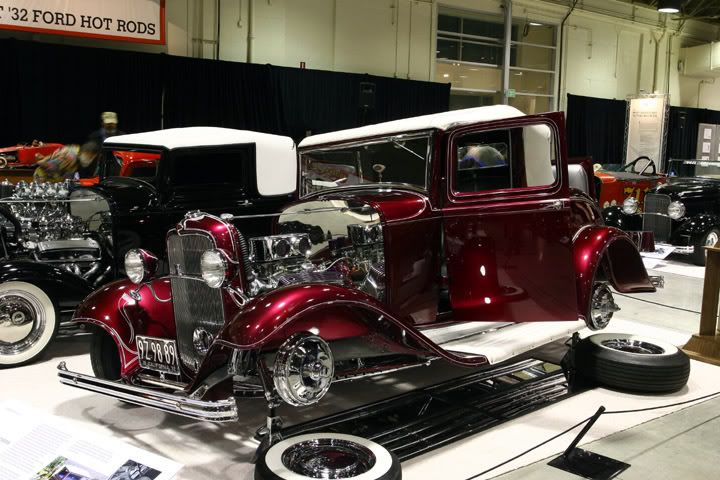
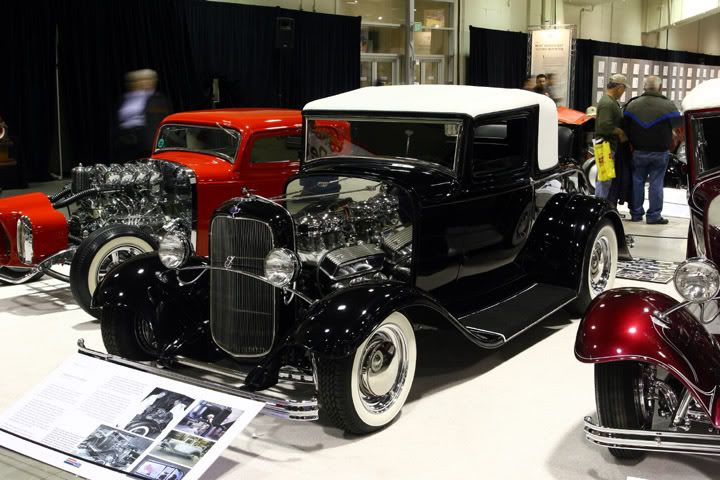
Yeah, it all comes back to hot rods one way or another.
The Jackman brothers were cool. I wish I could get my hands on a set of Alumi-Stars. I used to work at a parts shop in Costa Mesa and there was a guy who used to come in with this real neat old-school Baja. It had a narrow-eye kit and reduction boxes. It also had Alumi-Stars.
Incidentally, the Jackman bros, like a lot of people in the VW performance world, got their start in the hot rod world. In the 1950s they built two '32 Ford sport coupes--real rare cars but not very handsome in stock form.
Anyway, the cars were influential enough to be picked as two of the 75 most influential 1932 Ford hot rods. Ford sponsored a hall at the 2007 Grand National Roadster Show to display as many cars that remained of that list.
While the Jackman bros cars were long gone, they decided to replicate them for the event. Here they are:


Yeah, it all comes back to hot rods one way or another.
- bajaherbie
- Posts: 9967
- Joined: Sat Jul 15, 2006 7:07 pm
those '32's had some crazy induction systems......
i have a copy of the march, 1970 issue of Dune Buggies, the fun car journal (became hot vw's with the next issue) and there are twol ads for widened wheels...
g&r wheels, 807 e. first st., santa ana, ca. $9.75 exch.
the big wheels, 12865 main, garden grove, ca. $9.95 exch., safety bead, add $2.00, no core, $4.95
i was 10 years old at the time, those were the good old days
i have a copy of the march, 1970 issue of Dune Buggies, the fun car journal (became hot vw's with the next issue) and there are twol ads for widened wheels...
g&r wheels, 807 e. first st., santa ana, ca. $9.75 exch.
the big wheels, 12865 main, garden grove, ca. $9.95 exch., safety bead, add $2.00, no core, $4.95
i was 10 years old at the time, those were the good old days
Of all the paths you take in life, make sure a few of them are dirt.
-
Ol'fogasaurus
- Posts: 17881
- Joined: Mon Nov 13, 2006 10:17 pm
- hotrodsurplus
- Posts: 410
- Joined: Tue Sep 18, 2007 10:43 pm
Actually, the ones on the J-bros' cars are pretty tame: Edelbrock 2x4s on Y-blocks. They're basically unofficial E-code Thunderbird engines.crazy induction systems...
But the induction on that thing in the background....
That's Andy Kassa's car. The east coast movement was (and really still is) pretty famous for heavily chopped and channeled cars, and most people credit that very car for starting that trend in about '53. It's a Flathead-Ford powered car. Two Stromberg 97s make good power on a street Flathead, three will make a hot-street or race-only car go pretty fast, but four will only make you look like a squirrel unless you're a genius like Barney Navarro or Ak Miller (and not even they liked 'em). On top of having four carbs, each one has a velocity stack that splits in two--hence the crazy looking induction.
Take a look at page 36. Cragars with rag tires. See what I mean? Oh yeah, Don Emmons started at Hot Rod magazine a decade earlier. See? It's all about hot rods.1970 issue of Dune Buggies, the fun car journal
Actually, I just learned something: that red car is the clone (the way it looked in '62) but the black one is the real car (the way it looked in '59). Pat Ganahl just did a book about custom painting. He followed along as they painted that car. It's a true candy with a gold or silver base, a pearl overlay, and translucent top. I'm not real hot on exotic paint, but that car is gorgeous.I remember the red car most.
I agree wholeheartedly. Tom Ivo's T had those. I talked my buddy into 'em for his car. It's on the cover of the last issue of Rodder's Journal (#39). They make just about any car look good.Still like the '50 Merc caps on reversed (especially black) Merc rims and whites.

-
Ol'fogasaurus
- Posts: 17881
- Joined: Mon Nov 13, 2006 10:17 pm
- hotrodsurplus
- Posts: 410
- Joined: Tue Sep 18, 2007 10:43 pm
- Motochris
- Posts: 739
- Joined: Mon Feb 12, 2007 12:16 pm
Ohhhhh.....flashback. TV Tommy Ivo...... LOVED his 4 engined car....what was it called...Showboat? I saw it's last run when it had the wagon body on it.hotrodsurplus wrote:
Tom Ivo's T had those.
As a kid I hung around the Shrewsberry household...saw all kinds of interesting things.
Ooopsss...thread hijack.
-
kendel
- Posts: 734
- Joined: Mon Nov 12, 2007 4:32 pm
After all this i think the chiwanese steel wheels i got ar just about fine. I know I should weld a wheel up make the whole thing. one of welding wire thicker here thinner there, An easy too fix I never seen that done?bajaherbie wrote:which weighs more, a narrow BTR beadlock or a narrow 5 spoke steel wheel?
i can't remember but i think my wheels are 5" wide....i think the
BTR's are 4 or 4.5 inches..... maybe kendel will buy two BTR's and not like them and sell them to me at a huge discount....
- hotrodsurplus
- Posts: 410
- Joined: Tue Sep 18, 2007 10:43 pm
Ooopsss...thread hijack. Wink

Yeah, here's the funny thing...this on-topic forged/cast thread started in an off-topic post about the demise of American Racing wheels. Tako observed that it did the impossible: an off-topic thread suddenly turned on topic. An ironic twist...
You mean...THIS? (it's the one in the background)LOVED his 4 engined car....what was it called...Showboat?
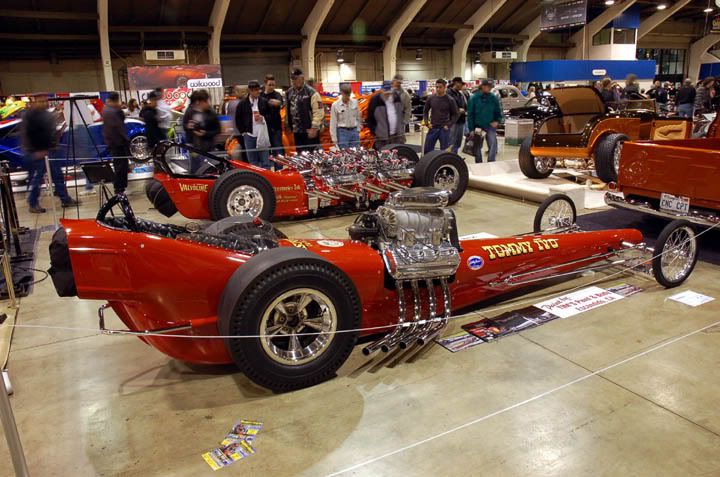
Or better yet, this photo from the day?

That car is neat--I think it started as a Scotty Fenn (Chassis Research) car but I could be wrong. I don't know if that's the one that eventually got the Buick wagon body, but it probably was. Those weird multi-engine cars (Peters and Frank's Freight Train and Ivo's side-by-side Nailheads) were reactions to the NHRA's ban on nitromethane starting in '57 and going to '64.
The four-wheel-drive jobs were an answer to the poor tire technology of the time. Purpose-built racing slicks M&H were around since '57 or so, but the wrinkle-wall slicks that we all recognize today weren't around until about '66. So if two engines could make more power than one, surely four drive axles could transfer power better than two.
Fritz Voigt and Mickey Thompson (THE Man--a reallyreally neat guy) built this originally for drags but later took it land speed racing. I don't know if it evolved into the Challenger or if the Challenger was a separate project, but this one was pretty dern hairy.

I'd say you did! For those of you who don't know who "Wild" Bill Shrewsberry was, he was one of the guys (along with Bill Golden and his Little Red Wagon) who pioneered the wheelstanding spectacles.As a kid I hung around the Shrewsberry household...saw all kinds of interesting things.
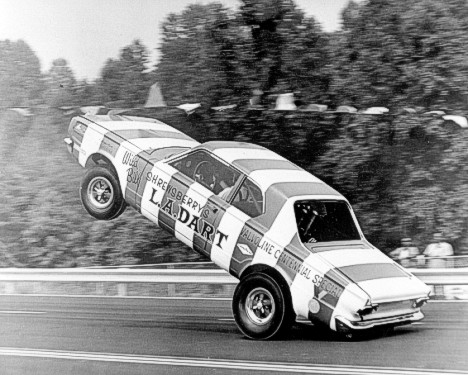
Again, I'd say you did. Parks was a real gem--a visionary, gentleman, AND businessman. Without him, Bob Petersen (Petersen Publishing--hot rod and all), Tom Medley, Eric Rickman, Dean Batchelor, and a few others, it's likely that we wouldn't be doing the things we're doing with cars. I mean look at it: Parks founded the NHRA to legitimize drag racing while he was the editor for the magazine created to legitimize the hot rod movement. Jack and Art Chrisman, too. Again, here's another hot rod/off road connection: Jack Chrisman is largely credited for starting the funny car movement by taking a Ford OHC engine to Bill Stroppe (built Big Ole, often ran Baja with Parnelli).Got to hang out with alot of the sports pioneers....Wally Parks, Chrisman, Kieth Black....
Keith Black, now there's a name.
Again, for those of you who are just stumbling into this hijacked thread, he and and guy named Tommy Greer and another upstart named Don Prudhomme (that one should sound familiar) commissioned Kent Fuller (the guy who made Ivo's single-engine slingshot above) to build the chassis. Due to its construction, it's one of the most competitive cars of its day. Due to its Wayne Ewing body (again, I think he did the one on Ivo's single) it was by most accounts the most handsome.
If you know how nitro smells and fueler sounds at sea level, you'll know why photos like this make me breathe faster.
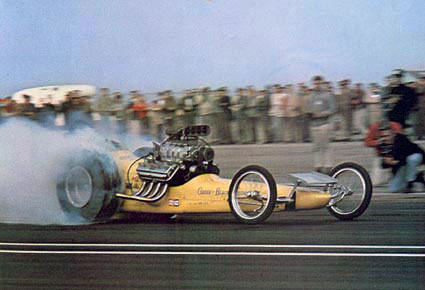
Man, the Greer Black Prudhomme car was the sh!t. Sure the modern 300-mph four-second racecars are impressive, but they're not real dragsters in the sense that was.
You're right. When a couple privateers could get together and race competitively--those were the days.
- Motochris
- Posts: 739
- Joined: Mon Feb 12, 2007 12:16 pm
Stop it...stop it....can't...handle...the memories.....
Bill had the LA Dart, Hemi under Glass and the Knott's Berry Wagon all at the same time at one point. LOVED the Berry Wagon as a kid. Doug Roses Green Mamba too.
I got to drive this car when I was 17 a few times....

'58 Dragmaster B. It was my girlfriends dads car. Dennis Garrett. He and Gus Leighton raced it from new. It was a Hot Rod magazine Top Ten car in 1960.
Ok....somebody is gonna have to fix this thread now.
Bill had the LA Dart, Hemi under Glass and the Knott's Berry Wagon all at the same time at one point. LOVED the Berry Wagon as a kid. Doug Roses Green Mamba too.
I got to drive this car when I was 17 a few times....

'58 Dragmaster B. It was my girlfriends dads car. Dennis Garrett. He and Gus Leighton raced it from new. It was a Hot Rod magazine Top Ten car in 1960.
Ok....somebody is gonna have to fix this thread now.